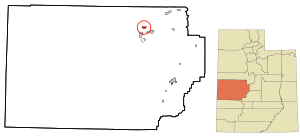Sutherland, Utah facts for kids
Quick facts for kids
Sutherland
|
|
|---|---|

Location in Millard County and the state of Utah.
|
|
| Country | United States |
| State | Utah |
| County | Millard |
| Founded | 1909 |
| Founded by | Myron Abbott |
| Named for | George Sutherland |
| Area | |
| • Total | 2.2 sq mi (6 km2) |
| • Land | 2.2 sq mi (6 km2) |
| • Water | 0.0 sq mi (0 km2) |
| Elevation | 4,626 ft (1,410 m) |
| Population
(2010)
|
|
| • Total | 165 |
| • Density | 75.0/sq mi (29.0/km2) |
| Time zone | UTC-7 (Mountain (MST)) |
| • Summer (DST) | UTC-6 (MDT) |
| ZIP codes |
84624
|
| Area code(s) | 435 |
| GNIS feature ID | 2584778 |
Sutherland is a small community in Millard County, Utah, in the United States. It's called a census-designated place (CDP), which means it's a special area defined by the government for counting people. In 2010, about 165 people lived here.
Contents
Where is Sutherland Located?
Sutherland is found in the north-central part of Millard County. It is about 4 miles (6.4 km) northwest of the city of Delta, across the Sevier River. Another town, Hinckley, is about 6 miles (9.7 km) to the southwest. The Gunnison Bend Reservoir is located about 5 miles (8.0 km) south of Sutherland.
Sutherland is one of several small farming communities in this area. Other nearby towns include Woodrow and Sugarville, which are just north of Sutherland. About 9 miles (14 km) to the west, you can find the historic site of the Topaz War Relocation Center.
The History of Sutherland
How Sutherland Began
In 1909, a large area of land northwest of the new city of Delta became available for farming. This land was part of the Carey Act, which helped people settle and farm in certain areas. Early settlers started gathering around the property of Myron Abbott, who is considered the founder of the community. At first, the area was known as North Tract or West Delta.
Growing as a Community
By 1912, the community had grown to 80 families, with 121 children old enough for school. Since county officials were slow to act, the people living there decided to build their own public schoolhouse in 1913. After that, residents asked for their own voting area and school district.
The name Sutherland was chosen to honor George Sutherland, an important political figure from Utah. At that time, he was serving as a United States senator. The Sutherland elementary school stayed open for many years, finally closing in the 1970s.
Who Lives in Sutherland?
| Historical population | |||
|---|---|---|---|
| Census | Pop. | %± | |
| 1920 | 446 | — | |
| 1930 | 438 | −1.8% | |
| 1940 | 507 | 15.8% | |
| 1950 | 428 | −15.6% | |
| 2010 | 165 | — | |
| Source: U.S. Census Bureau | |||
According to the 2010 census, 165 people lived in Sutherland. There were 53 homes in the community. Most of the people (95.8%) were White. About 3.0% were from other races, and 1.2% were from two or more races. About 6.1% of the population identified as Hispanic or Latino.
Notable People from Sutherland
- Carlos E. Asay—He was a member of the First Quorum of the Seventy of the LDS Church and was born in Sutherland.
See also
 In Spanish: Sutherland (Utah) para niños
In Spanish: Sutherland (Utah) para niños

